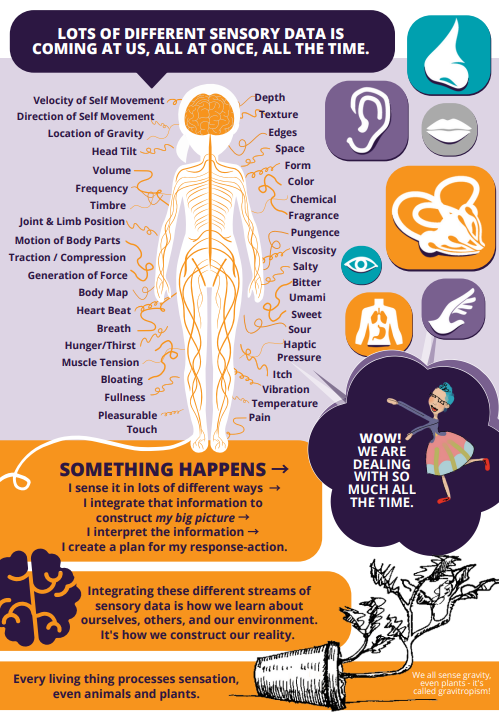Sensory Processing Disorder 101: What You Need to Know
“Children with sensory issues aren't misbehaving. They're having difficulty organizing the information from their senses and using it to function properly.”
—Lindsey Biel
Sensory Processing Disorder (SPD) affects 5% to 16.5% of the population, causing challenges in how individuals interpret sensory input. As an occupational therapist and a parent of two children with different sensory needs, I’ve seen firsthand how SPD impacts daily life. One child is a sensory seeker, constantly craving input, while the other is avoidant, overwhelmed by too much stimuli.
Once you understand SPD, behaviors that seem out of place—like avoiding loud noises or seeking intense physical play—make more sense. By identifying whether someone is hypersensitive or hyposensitive, specific strategies can be developed to help them navigate their environment.
This guide will break down SPD types, key signs, and how occupational therapy can create sensory-friendly interventions, improving life for children and adults alike.
What Is Sensory Processing Disorder?
Sensory Processing Disorder refers to the challenges some individuals experience when their nervous system has difficulty receiving, organizing, and responding to sensory information. This affects how we interpret input from our environment through the senses—touch, sound, sight, taste, smell, as well as the internal senses of body awareness (proprioception) and balance (vestibular).
In a well-regulated system, sensory processing allows us to respond appropriately to the things happening around us. For example, you might automatically step back when hearing a loud siren or adjust your body to balance on uneven ground. In individuals with SPD, the brain either overreacts or underreacts to stimuli, leading to overwhelming sensations or a muted experience of the world.
Understanding Sensory Profiles
Winnie Dunn’s Model of Sensory Processing explains how individuals experience sensory input through the interplay of neurological thresholds and behavioral responses. The four sensory profiles—Sensory Sensitivity, Sensation Avoiding, Low Registration, and Sensation Seeking—describe whether a child has a low threshold (hypersensitivity) or high threshold (hyposensitivity) for sensory input, and whether they passively accept sensory experiences or actively attempt to regulate them. This framework for SPD is often further simplified into 3 general types of sensory processing disorders.
The 3 Types of Sensory Processing Issues
Recognizing SPD can be challenging, as its symptoms often overlap with other conditions like ADHD and anxiety. It’s important to look for specific behaviors that suggest a child's sensory system is affecting their everyday functioning. Here are the common symptoms categorized under three main types:
1. Hypersensitivity (Sensory Avoidance)
Overreaction to Sensory Input: Intense reactions to stimuli, such as:
Covering ears in response to loud sounds, like sirens, vacuums, or crowded environments.
Gagging on certain food textures, such as mushy or slimy foods, and showing extreme food aversions.
Becoming distressed by light touch or specific fabrics, preferring soft, seamless, or tagless clothing.
Avoiding bright lights, frequently squinting or covering eyes in well-lit environments.
Refusing to walk barefoot on certain surfaces, such as grass, sand, or rough textures.
Crying or becoming upset during grooming activities, like hair brushing, nail cutting, or teeth cleaning.
Shrinking away from hugs or touch, even from familiar people, when feeling overwhelmed by sensation.
Becoming easily startled or anxious, especially in chaotic or unpredictable environments.
Types of Sensory Processing Disorders:
Sensory Modulation Disorder: Difficulty regulating sensory input, leading to overwhelming reactions.
Tactile Processing Disorder: Specific sensitivity to touch, textures, and clothing.
Auditory Processing Disorder: Heightened sensitivity to sound, making loud noises distressing.
2. Hyposensitivity (Sensory Seeking)
Underreaction to Sensory Input: Reduced awareness of sensory stimuli, leading to:
Seeking out strong sensory experiences, such as rough play or loud sounds.
Chewing on objects or clothes.
Spinning or jumping excessively
Crashing into furniture or people, intentionally seeking physical impact.
Constantly touching objects, surfaces, or textures
Ignoring or showing little response to pain, temperature changes, or other typically uncomfortable sensations.
Difficulty staying still, frequently moving or fidgeting to stimulate their sensory system.
Increased desire for fast, erratic movement, like running, bouncing, or swinging at high speeds.
Check out these 19 Therapeutic Activities for Sensory Seeking Kids for specific ideas.
Types of Sensory Processing Disorders:
Sensory Seeking Disorder: Craving more intense sensory input through activities like swinging or roughhousing.
Sensory Modulation Disorder: Difficulty managing the amount of sensory information, leading to impulsive seeking behavior.
3. Sensory Discrimination Issues
Motor Coordination Problems: Challenges with both fine and gross motor skills, including:
Clumsiness or difficulty with physical activities (e.g., sports, dancing).
Trouble with tasks requiring fine motor skills, such as:
Holding a pencil properly.
Cutting with scissors.
Buttoning or zipping clothing.
Balance and Proprioception Difficulties: Issues with spatial awareness, leading to:
Awkward or slow movements.
Difficulty navigating through spaces without bumping into objects.
Types of Sensory Processing Disorders:
Sensory Discrimination Disorder: Difficulty interpreting and differentiating between different sensory inputs, leading to challenges in body awareness and coordination.
Sensory-Based Motor Disorder: Issues related to movement and coordination stemming from sensory processing difficulties.
Diagnosing Sensory Processing Disorder
Diagnosing Sensory Processing Disorder involves a thorough evaluation led by an occupational therapist with advanced training in sensory processing. While SPD is not yet recognized in the DSM-5, professionals can identify it by connecting sensory challenges to difficulties in daily functioning at home or school. The process typically begins with screening, where parents may be asked to complete checklists and provide developmental histories. Observations from teachers, doctors, or therapists play a key role in this initial stage as well.
If further assessment is warranted, a comprehensive evaluation is conducted to examine sensory integration issues more closely. This may involve clinical observations in real-life settings to identify how sensory challenges affect participation in daily activities. Often, a multidisciplinary team, including specialists in speech, psychology, or medicine, may be involved to rule out other conditions like ADHD or Autism that can co-occur with SPD. Early diagnosis is important, as intervention in younger children is more effective due to the brain's adaptability, or "plasticity," helping prevent secondary issues such as social difficulties or low self-esteem from developing later in life.
Common Sensory Processing Disorder Assessments used by occupational therapists:
Sensory Integration and Praxis Tests (SIPT)
Bruininks-Oseretsky Test of Motor Proficiency™ - Second Edition
Movement Assessment Battery for Children - Second Edition (Movement ABC-2)
Miller Function and Participation Scales (MFUN)
Miller Assessment for Preschoolers (MAP)
Goal-Oriented Assessment of Life Skills (GOAL)
How Occupational Therapy Can Help
The primary goal of the occupational therapist is to help those with SPD engage fully in everyday life. OT is focused on enhancing functional skills. In pediatric OT, this could involve tasks like getting dressed, focusing at school, or engaging in social play. Therapy often revolves around sensory integration strategies for children (and adults) with SPD. Here’s how OT can help:
Sensory Integration Therapy: This is a core approach we use, focusing on providing sensory input in a structured and repetitive way. The idea is to help the brain learn how to process and respond to stimuli more effectively. We may use activities like swinging, deep pressure touch, or climbing to engage the vestibular and proprioceptive systems. These activities are designed to challenge the child’s ability to process sensory information while improving coordination, attention, and behavior.
Developing a Sensory Diet: Just like a nutritional diet provides the body with what it needs, a sensory diet provides the nervous system with the right types and amounts of sensory input throughout the day. This might include scheduled sensory breaks, such as time for jumping on a trampoline, using a weighted vest, or quiet time with noise-canceling headphones. The goal is to keep a child's sensory system in balance, helping them feel more regulated and able to participate in daily routines.
Environmental Modifications: Sometimes, small changes in the environment can make a big difference. OTs often work with families to create sensory-friendly spaces at home or school. This can mean reducing sensory triggers like bright lights or loud noises, or adding sensory tools such as fidget toys, seating options that provide movement (like a wobble cushion), or even providing calming scents to help regulate the senses.
Skill Building & Coping Strategies: Many kids with SPD struggle with frustration, anxiety, or behavior issues because of their sensory challenges. OT helps kids build self-regulation skills—learning how to calm themselves when overstimulated or seek out sensory input when feeling under-stimulated. This could be through deep breathing exercises, heavy work activities (like pushing or pulling objects), or learning how to ask for sensory breaks.
OTs often take a play-based approach, making therapy fun while working on these essential skills. The aim is to help kids participate in activities they love, whether that’s playing with friends, succeeding in school, or simply feeling more comfortable in their own skin.
Takeaway
Sensory Processing Disorder affects up to 16% of individuals, presenting unique challenges in how sensory information is interpreted and responded to. Understanding SPD is crucial for recognizing behaviors often misinterpreted as misbehavior, such as sensitivity to sound or a craving for physical stimulation. Early diagnosis and intervention are key, leveraging the brain's plasticity to prevent potential secondary issues like social difficulties and low self-esteem. If you suspect SPD then reach out to your primary healthcare provider for a prescription for OT (in the U.S.) for evaluation and treatment. Another good resource is the STAR Institute.
Related:



